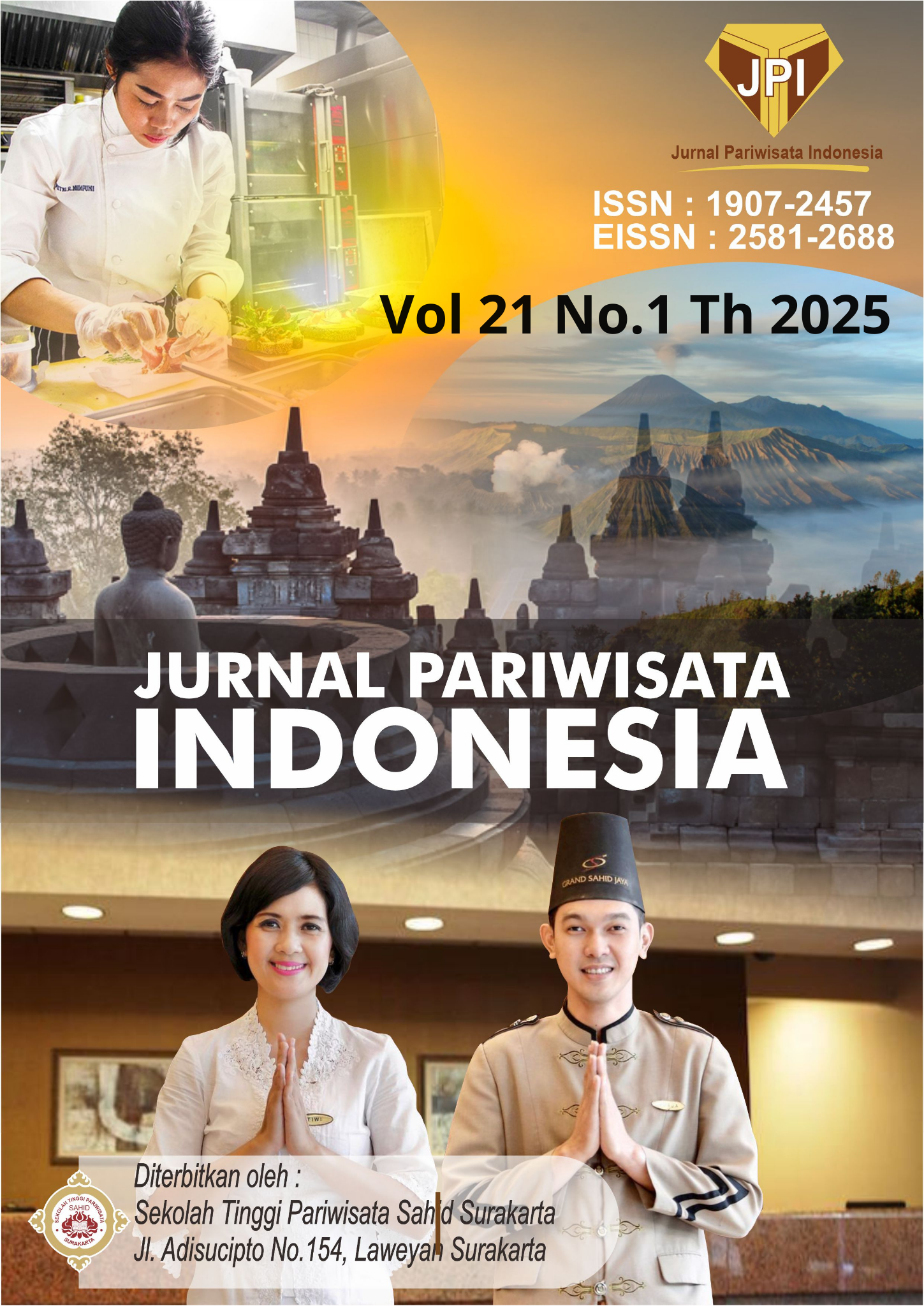STRATEGI PELESTARIAN BUDAYA DAN ALAM UNTUK PARIWISATA BERKELANJUTAN: STUDI KASUS KAMPUNG ADAT BANCEUY, SUBANG, JAWA BARAT
DOI:
https://doi.org/10.53691/jpi.v21i1.622Keywords:
Cultural Preservation, Environmental Conservation, Sustainable Tourism, Kampung Adat BanceuyAbstract
Kampung Adat Banceuy, located in Subang Regency, is one of the indigenous communities that continues to uphold traditional values and environmental conservation amidst the currents of modernization and tourism development. This study aims to explore the strategies for cultural and environmental preservation undertaken by the indigenous community, tourism village managers, Pokdarwis (Tourism Awareness Groups), and the role of tourists in supporting sustainable tourism. The research adopts a qualitative approach using a case study method. Data were collected through in-depth interviews, participatory observation, and documentation involving various stakeholders in Kampung Adat Banceuy. The findings reveal that preservation is carried out through the intergenerational transmission of customary values, community-based ecotourism management, and the implementation of local regulations for environmental protection. Collaboration among indigenous communities, tourism managers, and tourists emerges as a key factor in developing a sustainable tourism model. The study recommends strengthening customary institutions and enhancing community capacity in managing tourism in line with conservation principles.
Downloads
References
Apriliyanti, D. (2023). Pengelolaan sampah berbasis masyarakat dalam ekowisata berkelanjutan di Desa Wisata Sukunan, Sleman. Jurnal Pariwisata dan Lingkungan, 11(2), 142–153. https://doi.org/10.24843/jpl.2023.v11.i02.p03
Bickersteth, S., James, M., & Wilson, D. (2020). Community co-management of Uluru-Kata Tjuta National Park: Indigenous agency and shared governance. Journal of Ecotourism, 19(3), 239–257. https://doi.org/10.1080/14724049.2020.1786331
Bramwell, B., & Lane, B. (2011). Critical research on the governance of tourism and sustainability. Journal of Sustainable Tourism, 19(4–5), 411–421. https://doi.org/10.1080/09669582.2011.580586
Braun, V., & Clarke, V. (2006). Using thematic analysis in psychology. Qualitative Research in Psychology, 3(2), 77–101. https://doi.org/10.1191/1478088706qp063oa
Creswell, J. W., & Poth, C. N. (2018). Qualitative inquiry and research design: Choosing among five approaches (4th ed.). SAGE Publications.
Dita, P. R., Nugroho, H., & Saraswati, A. D. (2023). Revitalisasi budaya dan transportasi ramah lingkungan melalui wisata andong di Palbapang. Jurnal Pengembangan Pariwisata Indonesia, 15(1), 55–66. https://doi.org/10.31258/jppi.15.1.55-66
Ilhami, A., & Salahudin, S. (2022). Community-based tourism and local wisdom: A pathway to sustainable tourism development in rural Indonesia. Journal of Sustainable Tourism Development, 10(2), 87–98. https://doi.org/10.1016/j.jstd.2022.03.007
Miles, M. B., Huberman, A. M., & Saldaña, J. (2014). Qualitative data analysis: A methods sourcebook (3rd ed.). SAGE Publications.
Movono, A., Carr, A., & Mika, J. (2021). Indigenous tourism and the sustainable development goals: Perspectives from the South Pacific. Annals of Tourism Research, 90, 103260. https://doi.org/10.1016/j.annals.2021.103260
Peranginangin, Jasanta, (2025) Manajemen Desa Wisata, PT Indonesia Delapan Kreasi Nus, Jakarta.
Prihadi, D. J., Zhang, G., Lahbar, G. M., & Pasaribu, B. (2024). Integration of community-based tourism (CBT) index and biophysical assessment for sustainable ecotourism mangrove: A case study of Karangsong, Indonesia. Sustainability, 16(7), 2806. https://doi.org/10.3390/su16072806
Rahmiati, I., Wardani, R. K., & Yusuf, A. (2023). Model pengelolaan desa wisata berkelanjutan berbasis 4C di Desa Hegarmukti. Jurnal Pemberdayaan Masyarakat, 6(1), 33–47. https://doi.org/10.14710/jpm.2023.006
Reuters. (2025, May 6). Post-COVID boom in visitors sparks over-tourism fears in Asia. Reuters World News. https://www.reuters.com/lifestyle/travel/post-covid-boom-visitors-sparks-over-tourism-fears-asia-2025-05-06/
Rethinking sustainable community-based tourism for local livelihoods: Lessons from Pampang Village. (2021). Asian Journal of Tourism Research, 6(1), 20–34. https://doi.org/10.12982/ajtr.2021.6.1.20
Stronza, A., & Gordillo, J. (2008). Community views of ecotourism. Annals of Tourism Research, 35(2), 448–468. https://doi.org/10.1016/j.annals.2008.01.002
Sugiyono. (2019). Metode penelitian kualitatif, kuantitatif, dan R&D. Alfabeta.
Suryanti, N. M., & Indrayasa, I. N. (2021). Cultural preservation through community participation in Bali’s rural tourism. Tourism Planning & Development, 18(4), 459–472. https://doi.org/10.1080/21568316.2021.1913942
Susanto, B., Marthen, N., & Wanggai, F. (2023). Cultural tourism and indigenous governance: A case of the Kamoro people in Papua. Tourism Geographies, 26(1), 59–77. https://doi.org/10.1080/14616688.2023.2189780
Yin, R. K. (2018). Case study research and applications: Design and methods (6th ed.). SAGE Publications.Becherel, Lionel., Vellas, Francois. 2008. Pema Recommendation Pariwisata Internasional. Jakarta: Yayasan Obor Indonesia.
Downloads
Published
How to Cite
Issue
Section
License
Copyright (c) 2025 Afghani Mahmuda Bahreisy, Gita Siswhara

This work is licensed under a Creative Commons Attribution 4.0 International License.








